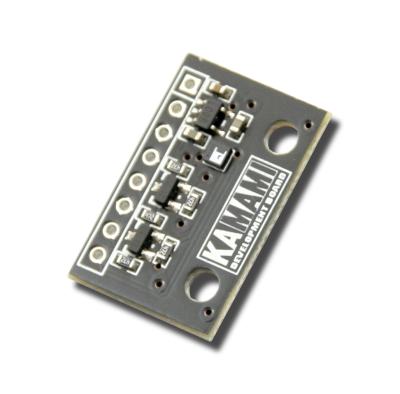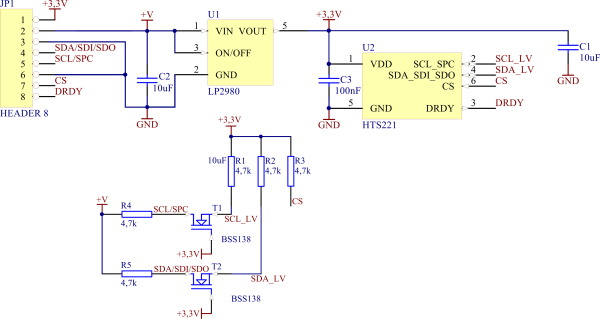KAmodHTS221: Difference between revisions
From Kamamilabs.com - Wiki
Anna Kubacka (talk | contribs) No edit summary |
|||
| (8 intermediate revisions by 4 users not shown) | |||
| Line 1: | Line 1: | ||
__jzpdf__ | __jzpdf__ | ||
====== Description ====== | ====== Description ====== | ||
[https://kamami.pl/ | [https://kamami.pl/en/air-humidity-sensors/558410-kamodhts221-humidity-temperature-sensor-module-with-hts221-system-5906623432547.html KAmodHTS221] is a module, which allow to make a measurement of humidity and temperature. Thanks to embedded voltage regulator and logic level translator, it can be used in embedded system with power supply 2.5 - 5.5V. Module KAmodHTS221 bases on humidity / temperature sensor HTS221 from STMicroelectronics. The characteristic features of this sensor are: measurement possibility in range 0 - 60°C or air humidity in range 0 - 100%. | ||
<center> | <center> | ||
[[ | [[File:KAmodHTS221_modul.png|none|400px|thumb|center]] | ||
</center> | </center> | ||
| Line 24: | Line 24: | ||
*Mounting holes 3mm | *Mounting holes 3mm | ||
*Module size (without connector): 24mm x 15mm x 3mm | *Module size (without connector): 24mm x 15mm x 3mm | ||
<br> | |||
===== Standard equipment ===== | ===== Standard equipment ===== | ||
| Line 41: | Line 42: | ||
===== Electrical schematic ===== | ===== Electrical schematic ===== | ||
<center> | <center> | ||
[[ | [[File:KAmodHTS221_schemat.png|none|600px|thumb|center]] | ||
</center> | </center> | ||
===== Outputs description ===== | ===== Outputs description ===== | ||
| Line 48: | Line 50: | ||
{| class="wikitable" style="width: 1000px;" | {| class="wikitable" style="width: 1000px;" | ||
|- | |- | ||
! style="text-align: center;" rowspan="10"|[[ | ! style="text-align: center;" rowspan="10"|[[File:KAmodHTS221 obrys PCB.png|center|200px]] | ||
! style="text-align: center;"|JP1 | ! style="text-align: center;"|JP1 | ||
! style="text-align: center;"|I2C | ! style="text-align: center;"|I2C | ||
| Line 89: | Line 91: | ||
*[http://mikrokontroler.pl/2016/08/31/projekt-kamodhts221-czujnik-temperatury-wilgotnosci-powietrza-ka Example for Arduino on MIKROKONTROLER.pl] | *[http://mikrokontroler.pl/2016/08/31/projekt-kamodhts221-czujnik-temperatury-wilgotnosci-powietrza-ka Example for Arduino on MIKROKONTROLER.pl] | ||
*[http://hobbyspace.pl/hts221-czujnik-temperatury-i-wilgotnosci-powietrza-z-wyjsciem-cyfrowym/ Example for STM32 on HobbySpace.pl] | *[http://hobbyspace.pl/hts221-czujnik-temperatury-i-wilgotnosci-powietrza-z-wyjsciem-cyfrowym/ Example for STM32 on HobbySpace.pl] | ||
Latest revision as of 16:51, 1 November 2024

Description
KAmodHTS221 is a module, which allow to make a measurement of humidity and temperature. Thanks to embedded voltage regulator and logic level translator, it can be used in embedded system with power supply 2.5 - 5.5V. Module KAmodHTS221 bases on humidity / temperature sensor HTS221 from STMicroelectronics. The characteristic features of this sensor are: measurement possibility in range 0 - 60°C or air humidity in range 0 - 100%.

Basic features and parameters
- Humidity / temperature sensor HTS221 from STMicroelectronics company
- Measurement range: 0 - 100% (humidity) / 0 - 60°C (temperature)
- Humidity measurement accuracy: ± 6% (0 - 100% RH) / ± 4.5% (20 - 80% RH)
- Temperature measurement accuracy: ± 1°C (0 - 60°C) / ± 0.5°C (15 - 40°C)
- Power supply voltage: 2.5V - 5.5V
- Power consumption: 9mA
- Measurement data rate (ODR): 1 - 12.5[Hz]
- ADC converter resolution: 16 bits
- Communication interface: SPI / I2C
- Embedded voltage regulator and logic level translator (SDA and SCL lines)
- Data ready output (DRDY)
- Place for soldering of pin header
- Mounting holes 3mm
- Module size (without connector): 24mm x 15mm x 3mm
Standard equipment
| Code | Description |
|---|---|
| KAmodHTS221 |
|
Electrical schematic

Outputs description
 |
JP1 | I2C | SPI |
|---|---|---|---|
| +3.3V | Module power supply | ||
| +VIN | |||
| GND | |||
| SDA/SDI/SDO | SDA | SDI/SDO | |
| SCL/SPC | SCL | SPC | |
| SDO/SA0 | SA0 | - | |
| GND | Additional ground | ||
| CS | CS | CS | |
| DRDY | Data ready signalization | ||